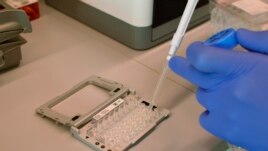23 March, 2019
Until recently, when scientists studied cells from people and animals, they often had to examine large samples, producing an average of results from many kinds of cells.
The process was like trying to learn about bananas by studying a smoothie -- a drink made from different types of fruit.
In recent years, scientists have developed methods that let them directly study the activity of cells and the genetic structure of individual cells. These techniques are now widely used and have provided information about how living organisms grow and develop. The techniques could also help scientists develop new treatments for diseases.
Single-cell revolution
A cell is any one of the very small parts that together form all living things. Cells each take on a job and work with their neighbors. In human beings, an average adult has around 37 trillion cells.
Single-cell analysis is the term for a group of techniques that scientists have developed for isolating, or separating, cells from living organisms. Scientists can study genetic material in each cell and learn about the relationships between cells. The result, notes the journal Science, is that researchers can follow the development of people and other organisms in incredible detail.
Francis Collins is the director of the National Institutes of Health, or NIH, a medical research agency that is part of the U.S. Department of Health and Human Services. Collins recently noted the importance of such techniques for understanding human beings. "Single-cell analysis is crucial for a comprehensive understanding of our biology and health," he said.

A scientist at the NY Genome Center in New York demonstrates equipment used in single-cell RNA analysis on Wednesday, Sept. 26, 2018.
In fact, the journal Science named the techniques that permit single-cell tracking of gene activity as its "breakthrough of the year" for 2018. "The single-cell revolution is just starting," the publication declared.
More precise questions
Jonathan Weissman is a stem cell biologist at the University of California, San Francisco. He notes that single-cell analysis lets scientists ask much more detailed, exacting questions than they could in the past. "It's like a flight recorder, where you are watching what went wrong and not just looking at a snapshot at the end," he said. "We can ask questions at a resolution that was just not possible before."
Nicholas Navin is a professor with the MD Anderson Cancer Center at the University of Texas. He uses single-cell DNA studies to discover patterns of mutations in cells of a cancerous tumor. These studies let Navin recreate when and where those mutations appeared as the tumor developed. That information helps him identify cells that contain combinations of mutations that make them the most deadly.
In the future, such research could be used to help identify what treatments to use for certain patients, Navin said. The research might also help doctors follow how well their treatments are working against a cancer over time. Ten to 20 years from now, Navin notes, doctors might be able to find cancers very early by identifying and studying the DNA of rare cells in blood tests.
Atlas of Cell Types
The ability to produce single-cell results for hundreds of thousands of cells at a time has created other new possibilities for researchers. One research group, the Human Cell Atlas Consortium, is creating a detailed listing of human cells. The research group, made up of more than 1,000 scientists from 57 countries, estimates it will eventually list at least 10 billion cells found in both healthy and sick people.
Aviv Regev is a biology professor at the Massachusetts Institute of Technology and a co-organizer of the project. Regev notes that the gene map has led scientists to identify genetic variants that raise or lower the risk of many diseases. But to turn this information into treatments, scientists must know in which cells those variants act. "We have to map all of them," she said.
Regev hopes for a first version of the planned cell atlas in about five years. To finish the job might take about 10 years, she estimates. "This is not going to cure all disease immediately," she said, but "it is a critical stepping stone."
I'm John Russell.
John Russell adapted this story from the Associated Press. George Grow was the editor.
_______________________________________________________________
Words in This Story
analyze – v.to study (something) closely and carefully; to learn the nature and relationship of the parts of (something) by a close and careful examination
breakthrough – n. a sudden increase in knowledge or understanding; an important discovery that happens after trying for a long time to understand or explain something
mutation – n. biology change in the genetic structure of a plant or animal that causes physical qualities that are different from what is normal
DNA– n. short for deoxyribonucleic acid.the carrier of genetic information
pattern– n. a model suggested for copying; something designed or used as a model
variant– n.one of two similar, but somewhat different things
sample– n.a representative part of something or a single object from a larger group